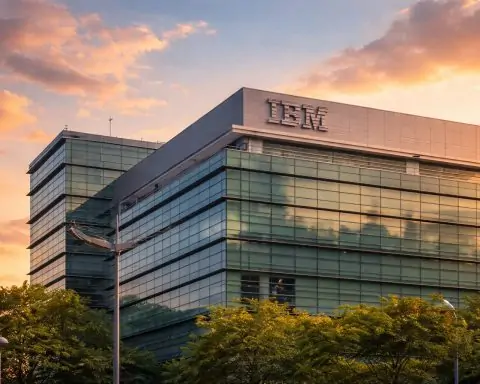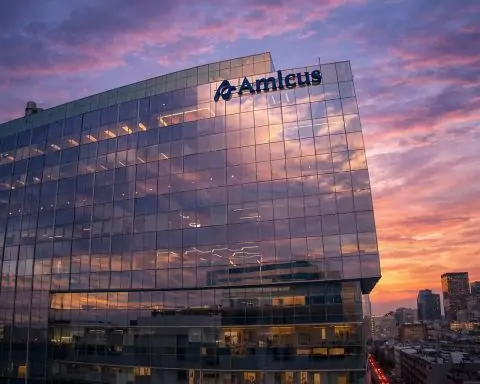- Record High: Navitas Semiconductor (NASDAQ: NVTS) jumped ~18% to around $17 on Oct. 20, 2025, reaching a new all-time high and extending its year-to-date gain to over 330% [1] [2].
- Nvidia Deal Catalyst: The stock nearly doubled in the past week alone after Navitas announced it will supply advanced gallium nitride (GaN) and silicon carbide (SiC) power chips for NVIDIA’s 800‑volt AI data centers [3].
- Pivot to AI & EVs: Under new CEO Chris Allexandre (ex-Renesas), Navitas is pivoting from phone chargers into high-growth markets like AI servers and electric vehicles [4]. This week it even launched a joint “Digital Power” lab with China’s GigaDevice to co-develop next-gen power solutions for AI data centers, EVs and renewable energy systems [5].
- GaN Tech Edge:GaN and SiC chips run cooler and switch up to 100× faster than silicon, enabling ~40% higher power efficiency [6]. These cutting-edge semiconductors are crucial for NVIDIA’s planned 800V DC “AI factories,” which require far more efficient high-voltage power delivery than traditional 48V systems [7] [8].
- Bull vs. Bear: Analysts are split. Bulls tout Navitas as “one of the most important growth stories of the decade” in EV/AI power chips [9]. Bears counter that an “enormous” amount of growth is already priced in – NVTS trades around 30× forward sales with no profits yet [10]. Short sellers have piled in (short interest ~25% of float [11]), reflecting skepticism and raising the risk of volatility.
NVTS Stock Extends Rally to Record High
Navitas’s stock continued its blistering ascent on Monday, October 20, 2025, touching an intraday high of $17.79 (a fresh 52-week peak) before closing around $17.06 [12]. That marks the highest level in the company’s trading history. Shares are now up over 330% in 2025 – a remarkable run from roughly $4 at the start of the year to the mid-teens today [13]. For perspective, NVTS traded as low as $1.53 within the past year [14]. The past week alone saw Navitas nearly double in value, with the stock surging 78% since last Friday’s close [15]. This explosive momentum has been driven by a major new partnership with Nvidia that positions Navitas at the heart of a next-generation chip trend.
Heavy trading volume and a rush of momentum buyers accompanied Monday’s jump. NVTS leapt about 18% on the day to ~$17.3 [16], extending a five-session win streak. Some of the spike may be attributed to a short squeeze dynamic: with roughly a quarter of Navitas’s float sold short [17], fast-rising prices likely forced some bearish traders to buy back shares, further propelling the rally. “It’s been a shoot-to-orbit move for what was once an obscure small-cap stock,” one market observer quipped, noting NVTS has become a high-flyer virtually overnight [18].
Nvidia Partnership Sparks AI Hype
Navitas’s big catalyst came last week. On Oct. 13, the California-based chipmaker announced it “developed advanced 800 VDC GaN and SiC power devices” for NVIDIA’s forthcoming AI data center architecture [19]. In effect, Navitas will be supplying critical high-voltage power chips for Nvidia’s next-generation “AI factory” server farms that run on 800-volt direct current. The news electrified investors. NVTS stock shot up 21% that day (closing around $9.97) and kept climbing – up 26% pre-market the next morning [20] – ultimately nearly doubling Navitas’s share price over five days [21]. By Oct. 16, NVTS hit $15.63, a 12-month high at the time [22], and the rally picked up again Monday.
Navitas’s management hailed the Nvidia collaboration as a watershed moment. “As NVIDIA drives transformation in AI infrastructure, we’re proud to support this shift with advanced GaN and SiC power solutions that enable the efficiency, scalability, and reliability required by next‑generation data centers,” CEO Chris Allexandre said in a statement [23]. For Navitas – a company founded in 2014 and known until recently for its fast GaN smartphone charger chips – being tapped by Nvidia is a powerful endorsement of its technology. Industry observers likewise see it as validation: one analysis even dubbed Navitas “one of the most important growth stories of the decade” given its unique focus on GaN/SiC power chips amid booming AI and EV demand [24]. In short, Nvidia’s backing instantly raised Navitas’s profile from niche player to potential key enabler of the AI revolution.
GaN Power Tech and the 800V Revolution
Why is Nvidia interested in Navitas’s GaN and SiC technology? The answer lies in 800-volt power architecture – a radical redesign of how data centers deliver electricity to racks of AI processors. Traditional cloud servers run on ~48V DC power; Nvidia’s upcoming “AI factories” will operate at 800V DC to feed energy-hungry supercomputing clusters [25] [26]. Higher voltage dramatically improves efficiency: moving from ~50V to 800V can transport >150% more power through the same cables with far less loss [27]. However, it also demands new power conversion hardware capable of stepping down and regulating such high voltages. This is where gallium nitride (GaN) and silicon carbide (SiC) chips shine.
GaN and SiC are wide-bandgap semiconductors that switch electricity much faster and handle high power with greater efficiency than legacy silicon components. Navitas claims its GaN transistors can boost power efficiency by about 40% and switch 100× faster than silicon equivalents [28] – crucial attributes for managing 800V DC in mega-scale data centers. These chips run cooler and waste less energy as heat, enabling more compact and efficient power systems. “Gallium nitride and silicon carbide devices are enabling levels of performance simply not possible with silicon,” Navitas co-founder Gene Sheridan has noted, emphasizing their value in high-voltage applications.
Nvidia’s embrace of 800V has set off an industry-wide race. At an Open Compute Project summit in October, Nvidia and partners detailed their 800V “AI factory” vision, and over 20 companies showcased compatible hardware [29]. Power giants like ABB and Vertiv rolled out 800V DC power equipment, while chipmakers Renesas, Analog Devices, and others unveiled controllers and components for 800V data centers [30]. This broad alignment underscores that the move to high-voltage AI infrastructure is a major trend – and Navitas has positioned itself squarely in the middle of it.
Navitas’s new GaN and SiC devices are purpose-built for this 800V revolution. They will be used in converters that take building-scale AC power and convert it directly to 800V DC, and in onboard modules that step 800V down to the few volts needed by GPUs. By providing these fast, efficient chips, Navitas helps enable Nvidia’s architecture to deliver more power with less energy loss [31]. If “gigawatt-scale” AI data centers become the norm, the demand for such high-performance power semiconductors could be enormous – a fact not lost on Navitas or its investors.
From Chargers to Supercomputers: Navitas Reinvents Itself
The Nvidia deal also reflects Navitas’s broader strategic pivot. The company built its early business on GaN-based power ICs for consumer electronics – notably ultra-fast phone and laptop chargers. But those are relatively low-margin, commoditized products. Sensing a bigger opportunity, Navitas has been reinventing itself as a supplier for AI, electric vehicle, and clean energy markets where GaN’s advantages command a premium.
This transformation accelerated in 2025 under CEO Chris Allexandre, a former Renesas executive who took the helm earlier this year [32]. Navitas raised $100 million in Q2 2025 to fund growth and is constructing a new GaN fabrication facility to boost production capacity [33]. The company has also actively sought partnerships: beyond Nvidia, Navitas formed a joint R&D “Digital Power Lab” with GigaDevice, a Chinese chipmaker, to co-develop high-efficiency power solutions for data centers, EVs and renewable energy systems [34]. It’s also collaborating with EV charger and solar inverter firms (Navitas has deals in the EV charging space, and its SiC unit GeneSiC serves automotive clients).
Navitas’s bet is that GaN/SiC will become ubiquitous in the high-power electronics that underpin AI computing, electric vehicles, 5G base stations, and smart grids. Company projections appear optimistic: Navitas’s co-founder envisions a roughly $2.6 billion combined market for GaN and SiC in AI applications by 2030 [35]. By pivoting now and securing marquee customers like Nvidia, Navitas aims to establish itself as a go-to provider of next-gen power chips – potentially capturing a meaningful slice of that growing pie.
This strategy shift seems to be paying off in market sentiment. Navitas’s stock price was languishing around $2–3 for much of 2024. Now, riding the AI wave, NVTS has become one of 2025’s top-performing semiconductor stocks [36]. It has vastly outpaced the broader chip index this year, and even industry heavyweights are taking notice. For context, TSMC – the world’s largest contract chipmaker – has also seen its stock hit record highs recently on surging AI chip demand [37]. The difference is that Navitas is a tiny upstart compared to TSMC or Nvidia, so any major design win (or loss) can have an outsized impact on its fortunes.
Analysts Eye Valuation and Risks
Amid the euphoria, a debate is raging on Wall Street about whether Navitas’s fundamentals justify its soaring stock. The company’s market capitalization now tops $3.1 billion [38], yet annual revenue is only in the tens of millions and it remains unprofitable [39]. By one estimate, NVTS is trading at a price-to-sales ratio above 45 (over 30× forward sales projections) [40] – an extremely rich valuation even in the frothy semiconductor sector. “An enormous amount of growth is already baked into the stock price,” one skeptical analyst warned [41], arguing that Navitas needs years of stellar growth to justify its current price. Any hiccup in execution – such as delays in ramping production or slower-than-expected AI orders – could send the stock reeling.
Most professional analysts are advising caution. Rosenblatt Securities, for example, downgraded Navitas to “Neutral” on Oct. 20 even as it acknowledged the Nvidia deal’s long-term potential. Rosenblatt’s analyst Kevin Cassidy raised his price target from $4 to $12 (a 200% increase) after the news, yet that is still well below the current trading price [42]. In fact, even $12 would represent a sizeable pullback from ~$17. The broader consensus is similarly muted: across eight analysts, the average 12-month target for NVTS is only about $6–7 per share [43]. That implies Wall Street sees the stock as over 50% overvalued at present levels. As of Oct. 20, Navitas had no “Sell” ratings but several Hold/Neutral ratings – a sign that even bulls have tempered their near-term expectations.
The bullish camp, however, argues that traditional metrics may undervalue Navitas’s strategic position. They point out Navitas is virtually the only pure-play GaN power semiconductor firm in the U.S. public markets – giving it scarcity value at a time when GaN/SiC are hot technologies. Optimists say Navitas could ride the AI and EV megatrends to become “a transformative company in power electronics” over the next decade [44]. They also note that giants like Nvidia and Tesla didn’t look cheap by conventional metrics in their early high-growth years. If Navitas executes well and captures design wins across data centers and EVs, its current valuation might eventually prove justified (or even modest).
In the near term, though, skepticism prevails. The presence of heavy short interest (~25–30% of float) reflects how many traders are betting that NVTS’s run-up will reverse [45]. This makes the stock’s ride especially volatile – rapid moves in either direction can cascade as shorts cover or re-short. Even some independent analysts have urged caution. Zacks Investment Research noted that while Navitas’s momentum is strong, recent positive revisions in its earnings estimates “may not translate into further price increase in the near term.” [46] In other words, a lot of good news is already priced in.
Outlook: High Hopes vs. High Bar
Navitas now faces the challenge of living up to the hype. The company will report its third-quarter 2025 earnings on November 3 [47], giving investors a peek at its financial progress. While no blockbuster revenue from the Nvidia partnership will show up yet (the AI chips are still in development), analysts will watch for updates on design wins, production ramp plans, and any new partnerships. Navitas’s guidance and commentary will be key to justifying its valuation. If management can demonstrate accelerating demand or additional “AI factory” customers, it could bolster the bullish case. Conversely, any hint of delays or a slowdown in its core business (e.g. slower GaN charger sales or customer pushouts) might spook shareholders who have enjoyed massive paper gains.
Broader market conditions will also play a role. The semiconductor sector in general has been buoyed by the AI boom of 2025, but it remains sensitive to economic swings and interest rates. Investors will be gauging whether Navitas’s story has the substance to endure beyond the current AI hype cycle. Navitas Semiconductor’s stock has undeniably ridden a wave of optimism – the task ahead is converting that optimism into tangible growth. With a foothold in Nvidia’s cutting-edge project and a war chest to expand production, Navitas has a real shot at becoming a long-term player in the power chip arena. Yet, at a 330%+ share price gain in one year, the company is now under pressure to execute almost flawlessly.
For now, NVTS sits at a crossroads of excitement and expectation. It has captured the market’s imagination by aligning with one of tech’s biggest themes (AI) and one of its biggest names (Nvidia). The coming months will reveal whether Navitas can turn this early lead in GaN power technology into sustained commercial success – or whether the stock’s gravity-defying rise will meet an equally forceful reality check. As one analyst put it, “Navitas has won the lottery in terms of attention. Now it has to prove it can deliver the goods.”
Sources: Navitas & Nvidia press releases; TechStock² (TS2.tech) analysis [48] [49] [50]; Reuters market data [51] [52]; GuruFocus/MarketBeat updates [53]; Motley Fool via Yahoo Finance [54]; Zacks Investment Research [55]; Navitas investor news [56]; TSMC AI demand context [57].
References
1. ts2.tech, 2. www.reuters.com, 3. ts2.tech, 4. ts2.tech, 5. ts2.tech, 6. ts2.tech, 7. ts2.tech, 8. ts2.tech, 9. ts2.tech, 10. ts2.tech, 11. ts2.tech, 12. stockanalysis.com, 13. ts2.tech, 14. www.reuters.com, 15. www.sharewise.com, 16. www.reuters.com, 17. ts2.tech, 18. ts2.tech, 19. ts2.tech, 20. ts2.tech, 21. ts2.tech, 22. ts2.tech, 23. ts2.tech, 24. ts2.tech, 25. ts2.tech, 26. ts2.tech, 27. ts2.tech, 28. ts2.tech, 29. ts2.tech, 30. ts2.tech, 31. ts2.tech, 32. ts2.tech, 33. ts2.tech, 34. ts2.tech, 35. ts2.tech, 36. ts2.tech, 37. ts2.tech, 38. www.reuters.com, 39. ts2.tech, 40. ts2.tech, 41. ts2.tech, 42. www.gurufocus.com, 43. www.gurufocus.com, 44. ts2.tech, 45. ts2.tech, 46. www.alphaspread.com, 47. navitassemi.com, 48. ts2.tech, 49. ts2.tech, 50. ts2.tech, 51. www.reuters.com, 52. www.reuters.com, 53. www.gurufocus.com, 54. www.sharewise.com, 55. www.alphaspread.com, 56. navitassemi.com, 57. ts2.tech






